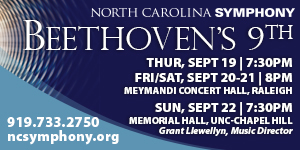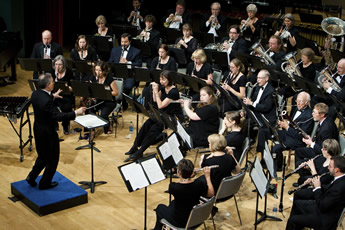For the first program of the Four Seasons Chamber Music Festival‘s 14th season, artistic director Ara Gregorian brought three piano quartets to the stage, all from Europe but not all alike. From the fourth decade of the 20th century came Joaquin Turina’s Piano Quartet in A-minor, Op. 67, while the last quarter of the 19th century was represented by Johannes Brahms and Antonín Dvořák quartets. Gregorian took the violinist’s seat, and frequent Four Seasons participants Colin Carr, cello, and Robert McDonald, piano, were joined by Hsin-Yun Huang, viola. The four performers made terrific music together and delighted a full house at Fletcher Recital Hall.
Turina’s quartet, from 1931, has both a Spanish flair and more modern sensibilities, but it is wonderfully accessible. Following a strong unison phrase in the three strings to open, the lento first movement moves into more of a string trio than piano quartet, but soon McDonald’s keyboard became a complementary player in the piece. At several points during the opening movement are noticeable silences or gaps in the piano part, which helps focus on interesting scoring for the three stringed instruments, including what seemed like some ghostly playing by Gregorian and Huang. The lively vivo movement was just that, with fine pizzicato playing over the piano, which was much more prominently displayed. The increasing emphasis on piano continues into the third andante: allegretto movement, which opened with Gregorian playing a nice exposed line and a long, slow passage with a most somber feeling. This movement has a most Spanish sound in both chord progressions and rhythm, but it also gradually intensified boldly among all four players. The strings were especially well played in unison sections at the end.
Brahms’ Piano Quartet No. 3 in C-minor, Op. 60 (1874), a reworked version of an earlier quartet, has parts that resemble a scaled-down piano concerto, while other parts reflect the most intimate of chamber music. The opening allegro non troppo movement has a sense of forcefulness and urgency, with particularly strong piano passages. The composer gives the viola a melody line accompanied by piano, which is then echoed by the violin up an octave and then echoed by the piano itself, including a shift into a minor key. In the second scherzo movement, the piano leads the other players in a section that builds in drama while maintaining quite a fast tempo. The interplay among musicians was top-notch, and McDonald helped hold things together with his excellent playing. With a pace that never flagged, this was the kind of playing by all musicians that kept the audience on the edge of its collective seat – and at least one player (Gregorian) took time to mop his brow at the conclusion.
The third movement, andante, is perfect loveliness, a wistful song that opens with a long cello-piano duet. Carr played with great sensitivity and feeling, and when Gregorian joined in, the delicacy continued. As Huang joined, the song’s beauty became an emotionally-charged highlight in the entire concert. The closing was exquisite, with Carr repeating the opening melody line. The finale: allegro comodo begins with a feeling of drama and builds in intensity as it moves toward a subtle ending with a final flourish. Along the way, the musicians summarized much of the sound that went before – large-scale ensemble and intimate ensemble, faster pace and more relaxed pace.
Dvořák’s Piano Quartet No. 2 in E-flat, Op. 87, is also a large-scale, four-movement work, but in more of a Czech or Slavonic idiom, with noticeable dance rhythms and an occasionally more buoyant feel than the Brahms quartet. Like Turina’s quartet, this piece opens with an allegro built on unison playing in the strings, an emphatic four-note figure that comes back more than once. The movement, which is not unlike the opening of the Brahms quartet in its rich fullness, builds to a sparkling conclusion before pulling back slightly and then pushing forward. As in the other quartets, Gregorian, Huang and Carr played almost as one, and McDonald provided excellent keyboard accompaniment, in both lead and supporting roles. The second lento movement features another fine duet between Carr and McDonald, this time played over softly plucked strings by Gregorian and Huang.
The allegro moderato, grazioso, third movement is a waltz right out of a European ballroom, with the added embellishment of familiar-sounding trills by McDonald at the end of several phrases. The mood of this movement shifts into a more intense, emphatic sound before returning to the lovely waltz. Huang and McDonald played a nice duet early in the finale: allegro ma non troppo movement, a passage that comes back at least two more times. McDonald’s piano is prominent throughout the entire quartet, especially the final movement, which includes shifts in key led by the piano and ends with quite a stunning climax.
Gregorian’s festival began with an excellent program expertly played from start to finish. It seems that no matter who the guest players are in the Four Seasons Chamber Music Festival, the audience is treated to absolutely top-level playing.
This program will be repeated at 3:00 p.m. in Raleigh’s Fletcher Opera Theater.













